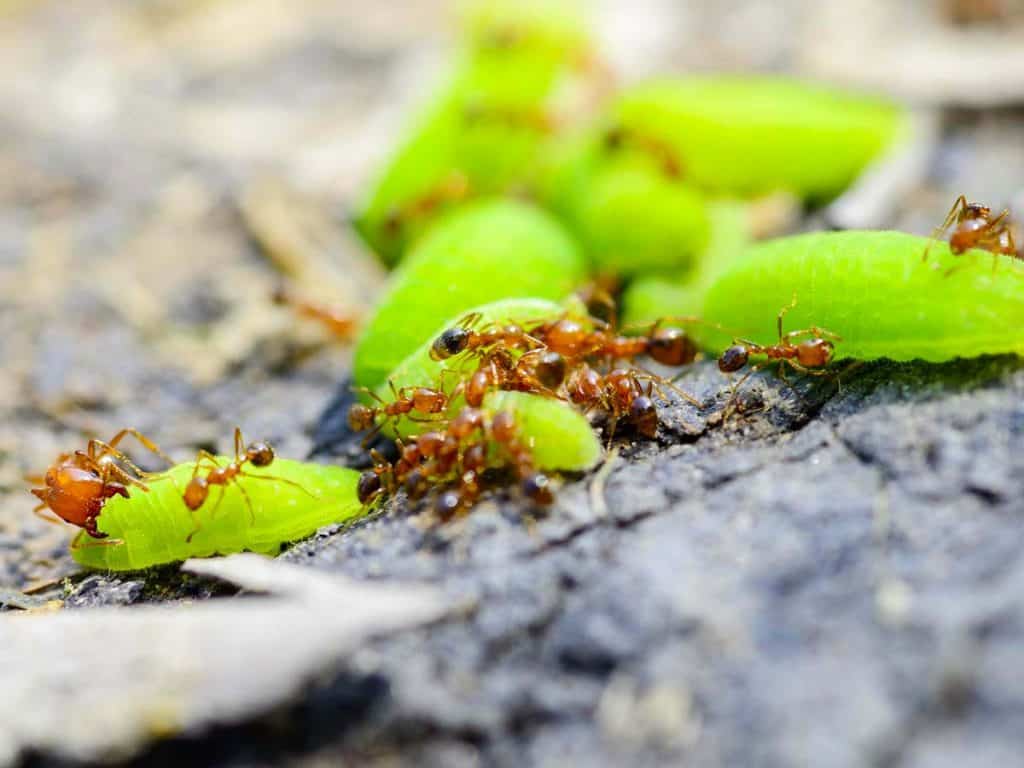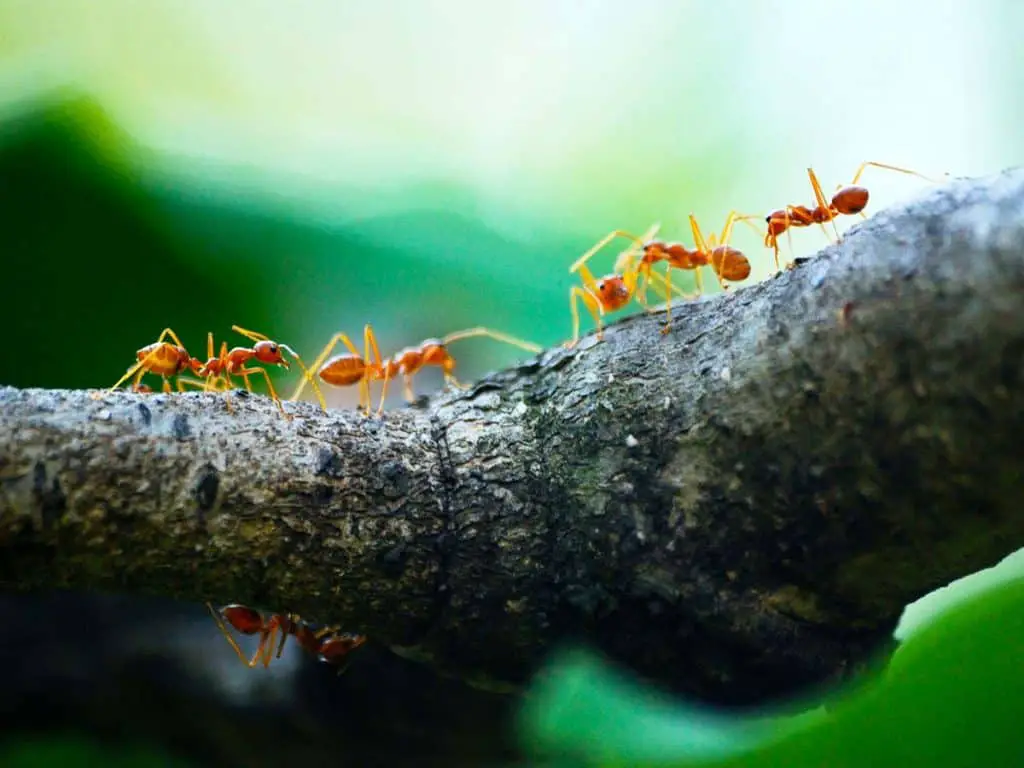Get Rid of Fire Ants (5 Potent Ways)
Fire ants are among the most notorious and aggressive ant species, capable of destroying the environment and ecosystem’s balance.
Fire ants ruthlessly invade, colonize, and kill insects or animals in the same habitat they supposedly share with and have an army that is ready to inflict severe damage when disturbed.
A fire ant infestation within your property is a ticking time-bomb that needs careful treatment, especially if you have kids and pets.
First, it is crucial to understand what attracts fire ants and their nesting habits, so you can focus on getting rid of them effectively.

What Attracts Fire Ants?
It is a generally accepted fact that ants eat sugar and sweet substances, solids or otherwise. Fire ants take that diet to another level that incorporates many types of animals and insects; they are omnivores.
What attracts fire ants includes the environment they thrive in and build mounds, and the foods that fuel them:
- Warm and dry open ground, under the sun or in the shade.
- Most types of soil.
- Rotten logs and around tree trunks.
- Fruits and sweet plant secretions.
- Insects and small animals – dead or alive.
In other words, you do not have much control over if or when imported fire ants nest but do your best in getting rid of them.
How big are fire ant colonies?
The average fire ant colony number between 100,000 to over a million, including one (monogynous colony) or multiple queens (polygynous colony) that lay eggs.
Considering their diet and adaptability, it is not difficult to imagine the destructive force they pose.

THE 5 WAYS TO GET RID OF FIRE ANTS
The best option for getting rid of fire ants depends on where the problem is – yard, lawn, flower beds, or vegetable garden. Choose the appropriate method to suit, so your precious plants are unharmed.
1. Borax Powder and White Sugar Mixture
How do you kill fire ants with borax?
Borax powder and sugar make an attractive but lethal bait for fire ants:
- Mix equal parts of borax powder and granulated white sugar in a container with a lid; shake well.
- Sprinkle the mixture on the mounds over the next few days to ensure the fire ants have a continuous supply to bring back to the colony.
- Reapply after rain as water dissolves the mixture.
2. Liquid Insecticide and Rubbing Alcohol Mixture
This DIY solution kills fire ants in your lawn or yard instantly:
- Mix 1-part rubbing alcohol (such as isopropyl alcohol) and 2-part liquid fire ant insecticide.
- Pour the solution over the fire ant mound in sufficient amount to drain into their tunnels and nest.
- Torch the mound’s surface and let the fire burn.
3. Bifenthrin Insecticide Solution
The insecticide product you buy typically contains 7.9% Bifenthrin – the active ingredient – regardless of brand.
(see recommended product later in the post)
You can get rid of fire ants in your lawn or yard with this method:
- Mix 1-part liquid Bifenthrin insecticide to 100-part water.
- Make sufficient amount for the fire ant mound(s) – you want enough volume to soak and penetrate deep into their nest.
- Always follow the safety precautions on the product label.
Check the product label if it is safe for use on flower and vegetable gardens before application around your favorite plants.
Some Bifenthrin insecticide products are safe for indoor use; pour the solution into a spray bottle for application in hard-to-reach places to get rid of fire ants in the house.
4. Boiling Water
Can you kill fire ants with boiling water?
If your fire ant problem outdoor is not extensive, boiling water kills fire ants instantly on contact. It is also an organic way that involves no use of undesirable chemicals but impractical when dealing with a severe fire ant infestation.
If you prefer an easy-to-apply treatment you can buy off the shelf without mixing solutions yourself, see the recommended product below.
5. Diatomaceous Earth
Diatomaceous earth kills insects by lacerating the exoskeletons and dehydrating them.
Does diatomaceous earth kill fire ants?
Food-grade diatomaceous earth can kill fire ants, but it disrupts their trails more than it kills as the ants learn to maneuver around it. Diatomaceous earth is ineffective in eliminating colonies.

The Best Way to Get Rid of Fire Ants in the Yard
Your two best options for killing fire ants in your yard include:
- DIY solution – Use Borax powder and white sugar equal parts mixture and spread it over the mounds as a poison bait, or
- Off-the-shelf solution – A 2-part powder and granule fire ant product that kills the colony and protects the yard from further infestation (see below).
How Do You Prevent Fire Ants in the Kitchen?
The presence of fire ants in the kitchen likely signals a nest in the yard outside the kitchen. There are possibly cracks in the walls or floor, which provided entryways for the fire ants searching for food and water.
Treating a fire ant problem in the kitchen would include exterminating them outdoors, and you need to target mounds closest to the kitchen.
You can prevent fire ants in the kitchen or any place indoors when you:
- Locate and remove their sources of food and water.
- Mix equal parts borax powder and white sugar in a bottle with a small opening; shake well and place it near the fire ants’ entry point. Leave the bait for 2-3 days to allow the fire ants to bring the bait back to their colony.
- Use an equal parts vinegar and water solution, liquid insecticide for indoor use, or rubbing alcohol to spray on the fire ants directly and along their trail to remove pheromones.
- Block or patch cracks in the walls or floor, and fix leaking pipes.
- Treat the fire mounds outdoor.
Best Fire Ant Killer for Lawn and Yard:
#1 Ortho Ant Killer

The best fire ant killer exterminates all the ants in a colony while protecting your yard for the following months.
It is a 2-part product that you must use for maximum results:
- Part 1 – A powder-form insecticide that you sprinkle on the fire ant mounds. The product destroys the mound and kills the queen when the ant workers bring it back to the colony.
- Part 2 – A granule-form product that you broadcast over the entire lawn or yard for protection for up to 6 months. It prevents fire ants and fly-in queens from neighboring areas from forming new mounds.
What you get with this fire ant killer:
- No watering-in required.
- Quicker application compared to DIY liquid solutions.
- You may need to use Part 1 again if small mounds appear after the 2-part application.
- Safe for the grass and pets.
- It stinks; strictly for outdoor use.
#2 Bifenthrin Concentrate 7.9% for Insect Control

This multi-purpose insect control product is especially useful in killing fire ants. Mix 1-part bifenthrin concentrate to 100-part water (or approximately 1 oz bifenthrin concentrate per gallon water) before application.
What you get with this fire ant killer:
- For use indoors and outdoors.
- Covers up to 44,000 sq ft.
- Can apply to some plants.
How to Identify Fire Ants?
An ant’s body can have one or two small “humps” (called nodes) between its thorax and the large abdomen in the rear.
Think of the fire ant’s body as four segments, in sequence: head, thorax, nodes, and (large) rear abdomen. The fire ant has 2 nodes; carpenter and sugar ants have one. It has a dull red color, ranging from reddish-brown to reddish-black, and a stinger.
What Does a Fire Ants Nest Look Like?
Identifying fire ant mounds and how deep their nests penetrate help you understand how extensive your fire ant problem is and the quantity of solution to prepare.
You can identify fire ant nests or mounds by the loose soil piles that are more often flat than conical and no more than a few inches tall. The mounds do not have openings above ground as the fire ants enter them from underground tunnels, which can go as deep as 10 feet but usually a few inches below the soil surface.

What Damage Can Fire Ants Do?
Few pest species cause as much damage to properties and the environment and disrupt human social life as fire ants.
The damage fire ants can inflict include:
- Damage plants by tunneling through stems and roots.
- Deter the cohabitation of other animal species that protects the natural ecological balance.
- Decimation of other native insect species, including other ant species.
- Reduce the population of pollinating insects.
- Fire ant stings can cause allergic reactions and could be lethal for small animals and pets.
- Fire ant colonies can reduce agricultural efficiency.
- Fire ant colonies in parks and beaches prevent human social activities, which may carry economic consequences.
When Are Fire Ants Most Active?
Fire ants are most active outside their mounds in late spring, summer, and early fall when air temperatures range between 65°F and 90°F. Within these seasons, warmer hours of the day will see fire ants remain in the nest, and they only forage outside later in the evening or at night when the temperature falls.
What happens when there is heavy rain?
Does the rain kill fire ants?
Heavy rain, unfortunately, does not kill fire ants. They band together to form pockets of air bubbles, which enable them to float on water. Fire ants will typically leave their mounds after rainfall to avoid drowning as water drains through their tunnels.
When is the Best Time to Kill Fire Ants?
During the months when fire ant activities are apparent, you aim for the best time to kill them depending on the treatment you apply.
The warmest hours of the day are the best time to kill fire ants with the liquid insecticide or alcohol fire solution. They are in the mounds to avoid the heat, and you ensure the solution penetrates deep into the tunnels to get rid of their nesting site. Alternatively, aim for the cooler part of the evening when the fire ants are foraging at or near the mound surface if you apply an above-ground treatment.
What Do You Do When You Get Bit by a Fire Ant?
Fire ant stings will burn, itch, and blister over the next hours and days.
When you get fire ant stings;
- Apply cold compresses to reduce swelling.
- Use a hydrocortisone topical cream or toothpaste on the sting site(s) to relieve itching.
- Seek medical treatment immediately if swelling or allergic reaction is severe.
- If pus-filled blisters develop, do not break them; if broken, treat them like an open wound by cleaning and dressing them to prevent infection.
What Animals Eat Fire Ants?
Fire ants do not have many enemies in the natural world.
These predators may eat fire ants but are otherwise of little help in controlling fire ants population:
- Armadillos
- Anteaters
- Some birds
